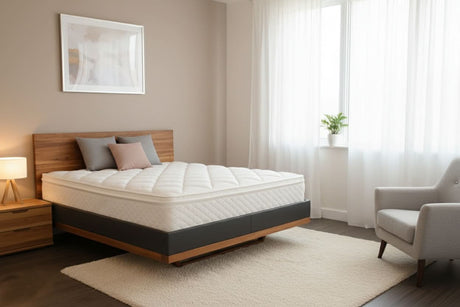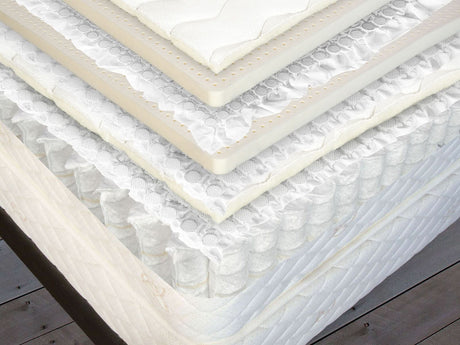This is a very in depth guide of some 3,000 words. If you’d like to read specific sections, there are links here to jump to an area of interest.
Steel springs have been an integral part of mattress construction since their introduction at the end of the 1800’s. Steel is a remarkable material which is incredibly elastic. When steel wire is wound into the shape of a coil its elasticity is greatly enhanced, allowing the coil to be compressed and to spring back into shape a nearly limitless number of times with little degradation in performance. This memory or spring is called elasticity and it is what provides support to us in a coil mattress. The use of steel springs in mattresses also greatly increases air circulation which dramatically improves hygiene; drier mattresses stay much cleaner over years of regular use, reducing bacteria and dust mite accumulation over time.
Bonnell springs, which were adapted from carriage seats, were the original spring system used in mattresses. Bonnell springs are very bouncy as they are joined together by use of steel lacing wires which connect the springs at the top and bottom. Bonnell springs are only found in the most basic of mattresses today.

The first coil system developed specifically for use in a mattress was invented by British-Canadian James Marshall. Called the Marshall spring, the first mattress coil system was—even by today’s standards—very advanced: the coils are individually wrapped in fabric, and arranged by hand in a honeycomb nested pattern. This allows the coils to move independently and to operate without gaps in the support system.
Steel springs used in mattresses have evolved over time, with most design changes intended to aide mass production. These innovations make large scale spring manufacturing easy, yet this method will never rival the quality of a hand arranged honeycomb nested Marshall coil.
The Elastic Bed Principle
The Mattress & Sleep Company curates its line of mattresses based on the ‘elastic bed principle’. Your mattress should be constructed of highly elastic materials for these three very simple reasons:
- Elastic materials conform better to the complex shape of the human body.
- Elastic materials rebound/bounce back to their original shape effortlessly, providing proper support from head to toe, and not just the heaviest parts of the body.
- Elasticity IS support. It is very important to understand that ‘softness’ and ‘firmness’ are entirely separate metrics and only loosely related to support. The elastic and conforming response of a softer spring is much more supportive to the human body than the firm and overly stiff support of the floor.
If you stand with your back against the wall, it should be immediately obvious that only certain areas of your body are touching the wall. Only the portions of your body which contact the surface of the wall are receiving any support.
Appropriate support requires contact with the mattress support layers. When we lay on a mattress that has an innerspring system which is too rigid or inflexible, it will straighten our spine to a degree. Our spine has a natural curve, and this curve needs to be supported, not straightened. This is precisely why, if a mattress needlessly straightens our spine, that people that are prone to chronic back pain. When a mattress is causing such an issue, it is almost always lower back pain. The lumbar spine is the most difficult part of the human body to support.
In simple terms, your mattress should support your body’s natural standing posture, and should not straighten your spine. Do not choose a mattress that is stiff and non-conforming. This would decrease support to the lumbar spine while simultaneously increasing pressure on common pressure points such as shoulders and hips which will negatively impact your sleep.

The Cairo Mattress is exceptionally elastic

(Higher is Better)
Types of Coils
Open Spring Mattresses
We tend to group coil systems together into two separate categories. Open coils are joined by steel helical lacing wires. Within this category we find: bonnell, offset and continuous coils. These coils are all shaped differently and there are certainly nuances of differences in comfort between one and the next. However, as the springs are joined at the top and bottom via helical lacing wires, the coil movement is restricted. For all intents and purposes, bonnell, offset and continuous coils serve the exact same purpose – lower manufacturing cost.
The comfort provided by any of these open coil mattresses is almost entirely reliant upon the upholstery layers, which is a flawed way to design a bed if we understand the importance of the elastic bed principle.
One of the largest problems with open coil designs is that they are a casualty of the mattress industry’s ‘race to zero’ – meaning the quality of foams and upholstery materials continue to decline. The lower the price of the mattress, the more susceptible it is to this drastic reduction in upholstery quality.
As the quality of the upholstery materials continues to be reduced, open coil mattresses suffer the most. Open springs are tremendously uncomfortable when the padding has worn through to the spring unit.
Coils joined by helical lacing wires tend to have a bouncy, unsettled feel. Generally, open coils are only found in budget mattresses. There are some rare exceptions, such as higher end offset coils (also called LFK springs). These types of higher end open coil designs make up an infinitesimally small part of the mattress market in North America and are largely inferior to a well engineered pocket spring.
The Mattress & Sleep Company does not offer spring systems with helical lacing wires as we believe pocketed springs are vastly superior in design and function.
Pocketed Spring Mattresses
Pocket coils are the other category of coil mattresses. Pocket coils are also known as Marshall coils or fabric encased coils. These coils are placed in their own individual fabric encasement and then either glued or sewn together in the middle of the springs to allow for independent movement.
Pocket springs are offered in a wide range of qualities and prices. The Mattress & Sleep Company have partnered with the best brands in the world to supply our range of pocket coil mattresses.
Pocket coils have become commonplace in the mattress industry. Generally, any spring mattress in Canada above $600 in queen size will be made with pocket coils. Lower quality mass market pocket coil systems will reduce motion transfer and not have a bouncy or cheap feel, making these springs a good choice for modest budgets.
Pictured here: The original patent drawings for the Marshall (pocket) coil.

The superior way of designing a pocket coil is to honeycomb nest the springs. Honeycomb nesting eliminates the large gaps found between the springs as each row is offset from one another. Honeycomb nested springs are used as the main spring in our Berkeley Ergonomics mattresses. These springs are sourced from well established suppliers in Germany and Sweden.
Honeycomb nested springs conform much more accurately to the shape of the human body and perform far better than standard inline or parallel pocket springs, due to much higher point elasticity. For even greater point elasticity, Vispring coils are arranged by hand into a honeycomb nested pattern, allowing maximum flexibility and unparalleled comfort.
On Point Elasticity
Point elasticity is the ability of a material to conform precisely to the shape of a human body. A more elastic spring system is a higher performing spring system. In these photos, we use the same wooden particle board (3 pounds) and iron weight (5 pounds) to demonstrate the difference in elasticity between different pocket spring systems. The curve of the board is to simulate the natural curves of a human body.
Here we have a standard pocket coil mattress from IKEA: this model is called the ‘Haugesund’. Please note the springs are arranged in straight rows and are ‘parallel’ nested with large gaps between the springs. We give IKEA a lot of credit; their coil count of 594 is a true coil count, and would be higher if they did not foam encase the perimeter of the springs. The foam density specs are provided and everything is as should be based on the specs on IKEA’s website. As of this writing, for $299 in a Queen, this is without doubt a great mattress for $300. Comparable options from standard retailers in Canada would typically be $600 or more.

IKEA Mattress
However; you can see that with the wooden board and the weight, there are considerable gaps between the board and the spring. 8 pounds may not sound like a lot of weight, but when it is only resting on 4 springs, this is far more pressure than the average person exerts on a spring system when laying down with their body weight spread out. This is not how James Marshall would have intended for a pocket coil system to behave, as in this example the upholstery is entirely responsible for the minimal comfort provided. Any mattress designed in this way is suitable for temporary use only.
Here we have the same board and weight placed on our Berkeley Ergonomics Malmo mattress. We can see that the honeycomb nested design allows for a much more flexible and elastic spring system. The coils themselves exert less pressure on pressure points, and require far less upholstery material to provide adequate comfort. It is not difficult to see why this is a superior performing coil system compared to that of your typical pocket coil mattress. This is also why genuine performance mattresses do not have pillowtops, such thick upholstery layers are unnecessary. This is a good thing, as the polyurethane foams used in standard pillowtop mattresses break down very quickly, thereby resulting in a short comfort life before deep body indentations and dramatic softening of upholstery layers.
 Berkeley Ergonomics mattress with 5 lb weight
Berkeley Ergonomics mattress with 5 lb weight
On Coil Counts
A typical mainstream queen size pocket coil mattress contains somewhere around 800 individual coils. On the lower end, you may see a queen size pocket coil count of around 600. This is a truer representation of spring density given that most mainstream mattresses are surrounded by a substantial foam perimeter. This foam perimeter removes several rows of springs, reducing both spring count and sleeping area.
It is true however, that coil count does not tell us everything about a spring system. The design of the coils themselves and how they are joined is the most important part; this is well illustrated by the difference in point elasticity shown in our photos of the various pocket springs in action.
Coil count, gauge of wire, and number of turns are not unimportant figures, it is however best to understand that these numbers are a direct consequence following the design of the spring system. There is a reason that most inline nested coils have a spring density of around 800 coils in a queen size mattress.
For example, using a honeycomb nested spring in our Berkeley Ergonomics Malmo mattress results in a substantial 1,484 springs in queen size. The point of the honeycomb nested springs is to allow much higher spring counts, which then gives us the capability of using thinner wire. This combination of traits maximize the comfort and elasticity of the spring system. Our Malmo mattress measures only a little over 8" thick with the 2" natural latex upholstery but weighs often 30% more than typical 14" deep mass produced pillowtop mattresses that also use pocket coils.
Of course, there are upper limits to the number of springs. Generally coil counts exceeding 1,500 to 2,000 in queen size would indicate the mattress has additional layers of springs, which are often categorized as micro springs.
Utilizing micro springs is an excellent innovation in recent years. By replacing foam layers with micro springs, not only will the mattress last longer, it will be more supportive. Micro springs are a clever solution to increase luxurious comfort without sacrificing performance.
The major innovator in micro spring technology is Harrison Spinks, a leading manufacturer in mattresses and also mattress components based in England. They produce their own pocket coil manufacturing machines in house, the worlds fastest, they also produce their own wire to achieve the ultra fine steel they need to produce the highest spring count micro spring layers available. Our select models from Harrison Spinks use between 9,000-25,000 springs total in a queen size mattress. This is the supreme way to make a comfortable, elastic and supportive mattress without using any foam in the mattress.
A clever use of micro coils in one of our most popular mattresses from Berkeley Ergonomics. Progressively more flexible spring layers towards the surface of the mattress increase comfort while retaining maximum response and elasticity due to a steel spring as close to the sleep surface as possible. The Berkeley Ergonomics Cairo mattress:
Upholstery Matters
Spring mattresses are upholstered with a variety of materials, mainly foam in contemporary offerings. In fact, there is so much foam in a typical spring bed that really, most of these are just foam beds that happen to have a spring unit somewhere at the bottom of all that foam! It is therefore of significant importance to distinguish the quality of upholstery itself that is used, not just the design of the springs.
The Mattress & Sleep Company approaches this problem in a unique way. Our coil mattresses from Berkeley Ergonomics are upholstered only with 100% natural Talalay latex foam, never low density polyurethane foam. The foam that is used, is replaceable for a reasonable cost due to the open zipper design of the mattresses. We only wrap these materials in pure stretch-knit cotton and sheep’s wool. This is far more breathable, elastic and durable than any mainstream mass produced mattress and ultimately a better performance and value proposition for long term use. The removal latex layer in our Berkeley Ergonomics Berlin: 
To go one step further, Harrison Spinks mattresses are only upholstered with 100% natural fibre fillings such as long staple cotton, hemp, flax, British wool, mohair, cashmere and supremely elastic genuine horsetail. Micro springs being used on both sides greatly increases comfort compared to other traditional mattress makers that have similarly opted to go the zero foam route. This is the most hygienic, temperature and humidity regulating type of mattress. A cross section view of a Harrison Spinks (Somnus is the branding of the same products made for England and Europe) mattress:
Our Harrison Spinks mattresses, such as our best-selling Northumberland are fully reversible for much longer comfort life than standard mattresses. While natural fillings do compress as all kinds of upholstery does, these mattresses are not dependent on the fillings for comfort and support the way that mainstream beds are dependent on polyurethane foam. The fillings here are used for temperature and humidity control. A more sumptuous surface like this will take the shape of the body with use, but will maintain tremendous performance even when well worn in compared to mattresses that depend on polyurethane foam.
Typical Mainstream Coil Mattresses
This image shows the construction of a typical mattress from a box retailer. The example shown is a Kingsdown mattress, yet, it could really be any of the standard brands – they’re all made in a very similar fashion.
The springs in this mass produced mattress are very firm in comparison to the low density polyurethane foam on top. Not only does this upholstery break down and soften up rapidly, it is the only part of the mattress that compresses easily. It may sound counter intuitive but if the springs in the mattress do not compress with the foam then they are simply not working and not producing a support function for the body.
 Mass-Market Pillowtop Mattress
Mass-Market Pillowtop MattressLow density polyurethane foams are very low in elasticity compared to steel springs and performance latex foams; the performance is mediocre when new and after a few short years the softening of the polyurethane foams can cause low back pain and as a result people replace mattresses much more frequently today.
The average mattress lifespan today is approximately 3-5 years. This means some people keep their mattress for 10 years, while others may get 12 months before experiencing significant wear issues.
These disposable mattresses continue to represent the overwhelming majority of mattress sales. If your current mattress is worn out or no longer meeting your needs, chances are the new mattress in the showroom will feel better, regardless of the cost or construction.
Polyurethane foams are made of plastic which does not allow much airflow, polyester fibres used for the fabric do not wick moisture, causing the common overheating phenomena plaguing modern mattresses both spring and all foam alike.
The quality of materials in mainstream mattresses is comparable to the IKEA mattress sample shown above yet often these mattresses sell for as much as $2,000 or $3,000—even when they’re ‘on sale’ at ‘half price.’
Given that virtually any mainstream mattress is designed either with springs and foam or all foam, there is a high probability that your current mattress is made from these same materials, regardless of price or brand. If you’re curious, the law label on your mattress will disclose the materials inside!



























